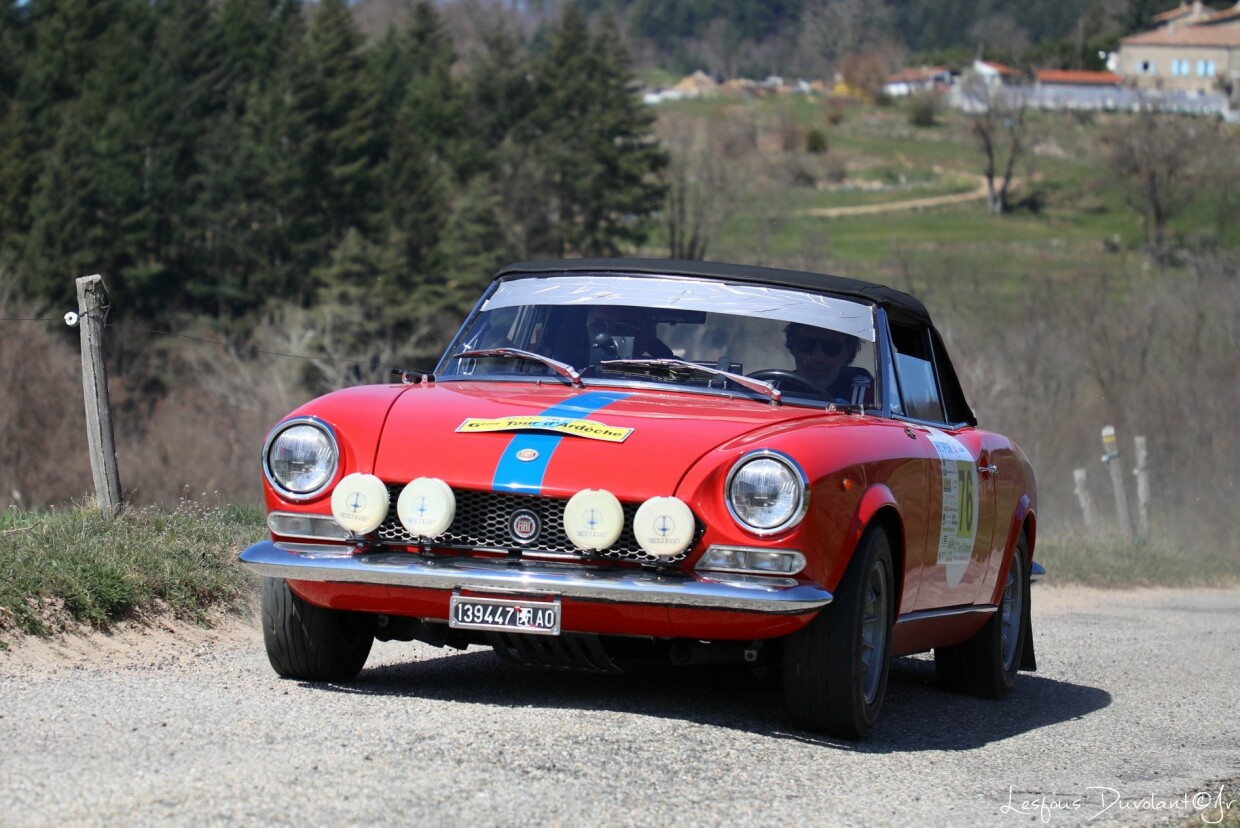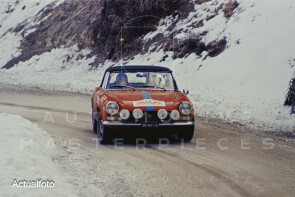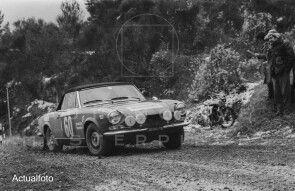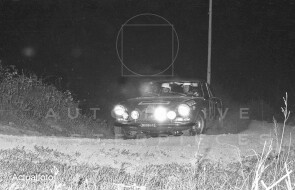
1969 Fiat 124 Sport Spider
ON/OFF
Why am I an Automotive Masterpiece?
H. Works cars
Despite the management of the era claiming it was too early to speak of an official Fiat team, it is one of the first examples entered into competition directly by the parent company.
L. Limited edition cars
no. 4 manufactured, 1st built
Presented in 1966, the 124 was aimed at the Italian petite bourgeoisie who, coming from Fiat 1100 and 1300 models, desired a more modern car, yet equally solid, reliable, and reassuring. The model had a long development process; Dante Giacosa studied three different projects: one (Project 124) with a front engine and rear-wheel drive, one (Project 123 E4) with a front engine and front-wheel drive, and another with a rear engine and rear-wheel drive. The more traditional Project 124 was preferred. Initially available only as a 4-door sedan, the 124 featured classic mechanical solutions: rear-wheel drive and a live rear axle, but with coil springs and coaxial shock absorbers instead of leaf springs. The three-box design was very squared and, according to the standards of the time, highly modern. Noteworthy for the period and its category were the four-wheel disc brakes. The engine was a new 4-cylinder inline with a side camshaft and pushrod valve distribution, displacing 1197 cm³ and producing 60 hp, designed by Aurelio Lampredi. Combined with a four-speed gearbox, it delivered good performance: the declared top speed was 140 km/h, but in a road test by Quattroruote magazine, the car exceeded 146 km/h, with an impressive acceleration from a standstill. All of this, however, with modest fuel consumption. A few months after the launch of the sedan, the Familiare, the Sport Coupé, and the Sport Spider designed by Pininfarina were introduced. The model received great public and critical acclaim: the 124 sedan was awarded the 1967 Car of the Year prize, the first for Fiat. Several updates followed, and the sedan's production continued until 1974.
The Fiat 124 Sport Spider is a 2+2 convertible sports car, presented to the public in November 1966 at the Salone dell’Automobile in Torino, and it replaced the previous "1500 S" and "1600 S" sports models in the lineup. The Sport Spider was built on the shortened chassis (unlike the coupé) of the 124 sedan, and equipped with the sedan's 4-cylinder engine, enlarged to 1438 cc, in a twin-cam version, powered by a dual-barrel carburetor, capable of delivering 90 hp at 6500 rpm. The timing system, advanced for its time, used a rubber toothed belt. The cylinder head was aluminum, of the “crossflow” type. The declared top speed was 170 km/h, a figure also surpassed in Quattroruote's road test. The engine later saw continuous evolution in displacement (up to 1995 cc) and fuel systems (carburetors, injection, supercharging) until 1985, when production ended. This family of engines, designed by former Ferrari chief engineer Aurelio Lampredi, became one of the longest-lasting engines in automotive history and powered many famous competition cars, including the 124 Abarth Rally. The Fiat 124 Sport Spider came standard with a new five-speed gearbox. The chassis featured a rear suspension modified at the attachment points with two pairs of longitudinal struts, replacing the previous "cross" layout to improve driving precision, and a brake booster. Each axle was fitted with a stabilizer bar. Designed and later produced by Pininfarina, the spider’s design was the work of Tom Tjaarda. By 1969, the 124 Spider had become the most affordable car with a twin-cam engine, four-wheel disc brakes, and other features typically found in higher-end models. In 1969, the second series was introduced, recognizable by the bulges on the hood, while the third series hit the market in 1972. At the end of its production run, the 124 Spider was removed from FIAT’s lineup, and production was handed over to Pininfarina.
The Fiat 124 Sport Spider, chassis no. 124BS*0023977*, from 1969, is one of the first cars used semi-officially by Fiat for its rally debut. During the 1960s, rally racing was becoming increasingly popular. For car manufacturers, it was a way to test new solutions using mass-produced models and gain significant publicity. Some private drivers began racing modified 124 Sport Spiders in various international rallies, achieving good results despite an unfavorable weight-to-power ratio, thanks to the car's structural strength and well-balanced weight distribution, which enhanced its road holding. The Fiat management, traditionally reluctant toward motorsport, recognized the car's potential and decided in the fall of 1969 to prepare, unofficially, three "Group 1" 125 Specials and four "Group 3" 124 Sport Spiders for the Campionato Italiano Rally and selected World Championship events. An improvised team was specifically formed under the “Direzione Assistenza Tecnica Autoveicoli.” The modifications made by engineer Giovanni Sguazzini and mechanic Almo Bosato focused on the engine, boosting its power to 120 hp. Cars and rally-related materials were stored at a workshop in Fiat’s Corso Bramante headquarters, later moved to the larger Corso Giulio Cesare branch. The rest of the preparation was entrusted to a prestigious partner, Virgilio Conrero's Autotecnica. The cars were equipped with roll bars, racing setup including competition seats and belts, navigator instruments, suspensions with stiffened rubber joints, and racing shock absorbers. This collaboration between Fiat and Conrero was unique, as Conrero soon signed a contract with Opel, and Fiat would later task Abarth, which had been absorbed and transformed into an internal racing division, with developing an official 124. Engineer Sguazzini, acting as spokesperson, claimed it was too early to speak of an official Fiat team, but in reality, the 124 cars racing at the 1970 Monte Carlo Rally had sequential "Torino" plates, something impossible for a private team, specifically: TO D01061, TO D01062, TO D01063, TO D01064. The Fiat 124 Sport Spider, chassis no. 124BS*0023977*, was the first of this batch of four cars, with the license plate TO D01061. Completed on December 30, 1969, and homologated by the FIA for the model, the car was registered to S.P.A. Fiat Servizio Rimessa Vetture Torino and, on January 16, 1970, was immediately entered into a snowy Monte Carlo Rally with the Rubbieri-Cavriani team. Its debut was a success: chassis no. 124BS*0023977* finished first in class and 19th overall, generating extensive press coverage. At the 1st Rally d'Italia - Sanremo Sestriere and the Rally Isola d'Elba, it was less fortunate, but it finished 9th overall at the Rally 999 Minuti. At the Rally del Friuli E Alpi Orientali, it came 2nd in class and 13th overall. However, by the end of the year, its noteworthy career was already over. In the fall of 1970, the car was sold to an enthusiast in the province of Biella, a rally hub, and since then, it has enjoyed the status of a collector's car. It is assumed that on that occasion, at the end of its racing career and before being sold to private buyers, the original engine was replaced with a new unit, the current one labeled AC3.000, of the type installed in the Special T sedan, which shares the same characteristics as the 124AC.000 unit installed in the Sport Spiders. In 1988, it was repurchased by a nostalgic Franco Cavriani, the co-driver of Fulvio Rubbieri at the 1970 Monte Carlo Rally, and it has since passed through other collectors' hands. The car has been restored and currently presents itself in its original “Group 3” livery, while the stock road parts have been preserved separately. The car is mechanically equipped with a limited-slip differential and brake force distributor; the interiors are Group 3-compliant, and the original seats have side-padding covers for containment. Other original rally-era details have been preserved, such as the navigator's footrest, a fabric document pouch on the right door, and a tool pouch on the seatback. It has a homologated roll bar, a fitted sports steering wheel, and the original wheel. Along with the installed engine, used in historic car competitions, the car comes with a correct 124AC.000 unit. Regarding documentation, the car was re-registered in Vercelli and is currently plated in Aosta. It can easily be restored to its original TO D01061 plate, which it had during the Monte Carlo race, thanks to new regulations. The car is awaiting its ASI C.R.S. certification and is currently competing successfully in historic racing events.




